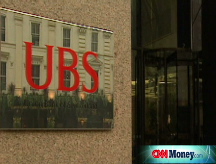Bank stocks plunge on bailout letdown
A lack of details in the Treasury plan sends bank stocks sinking Tuesday, with many wondering 'Will it work?'
NEW YORK (CNNMoney.com) -- The Obama administration finally unveiled its plans to fix the ailing banking industry Tuesday. Too bad Wall Street hated it.
Bank stocks sold off broadly and investors didn't make any differentiation between seemingly secure companies like JPMorgan Chase (JPM, Fortune 500) and Wells Fargo (WFC, Fortune 500) and beleaguered institutions such as Bank of America (BAC, Fortune 500) and Citigroup (C, Fortune 500).
All four stocks suffered double-digit percentage losses in their stock prices.
Other major banks that have received capital injections from the controversial Troubled Asset Relief Program, or TARP, including Wall Street giants Morgan Stanley (MS, Fortune 500) and Goldman Sachs (GS, Fortune 500) lost 7% and 12% respectively. The KBW Bank Index, a key gauge of bank stocks, plunged nearly 14%
Details of the plan were sketched out Tuesday morning by Treasury Secretary Tim Geithner in a speech in Washington, D.C.
Among the four key components were measures that would pave the way for providing more capital to struggling banks and encourage private investors to buy toxic assets from financial institutions.
Even as the plan won some praise from seemingly disparate groups - including House Financial Services Committee Chairman Barney Frank as well as some organizations representing the financial services industry - many investors faulted it for its lack of details, particularly how the different components of the plan would work.
"We don't know anything more than we knew a week ago, or even a day ago," said Jon Fisher, a portfolio manager for Fifth Third Asset Management in Minneapolis.
Treasury's plan, which included designs to remove troubled assets that continue to clog the balance sheets of many financial institutions, first leaked late last week, sending stocks across the banking sector broadly higher.
The agency confirmed Tuesday that the plan would include some of those measures, along with the expansion of Federal Reserve's Term Asset-Backed Securities Loan Facility, which lends money to investors to purchase securities backed by credit cards, auto, student and small-business loans.
Geithner said that he also hoped to lure in private investors with the creation of a partnership that would rely on public financing to buy as much as $1 trillion in troubled assets.
But without further information about the program, some fear that the appetite of private investors may be limited.
"Right now the 'Geithner Plan' is 'if you build a framework for private sector involvement, they will come.' Let's hope so," wrote Peter Boockvar, an equity strategist at Miller Tabak, in a note to clients Tuesday.
At the same time, the question remains of how to value the assets on banks' books. If investors pay too much, the taxpayer suffers. But if they pay too little, the banks will take a further hit.
It also stands to reason that some financial institutions may not even be willing to sell those assets given how aggressively they have marked down their values over the past year.
"It is real cut and dry," said Fisher. "No one wants to take their medicine, but the stock market is not waiting around."
Adding to Tuesday's selloff are broader fears that banks may yet again need another massive dose of capital.
Geithner said Tuesday that part of the remaining $700 billion would go towards some of the nation's leading banks, after they underwent rigorous stress-testing.
But there has speculation recently whether that is hardly enough to revive many of these large institutions. Some analysts have argued that the banking industry may need as much as $1 trillion in additional capital.
One expert thought the plan could work, however.
Don Ogilvie, the former head of the American Bankers Association who now chairs the Deloitte Center for Banking Solutions, said that if the government manages to scour the books of large banks and provides much better clarity about the underlying health of these firms, some financial institutions may eventually attract much-needed capital from the private sector.
"You may find once the government puts the proper amount of stress-testing and capital in, the private sector may be willing to come in and buy new equity in financial institutions," he said.
But judging by Tuesday's selloff, that day definitely hasn't come yet. ![]()



